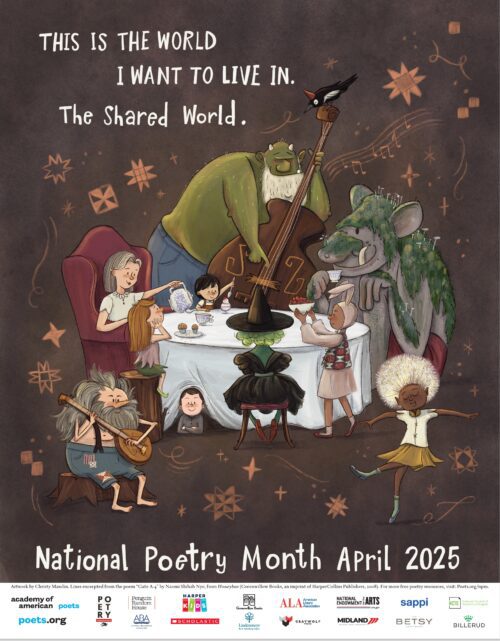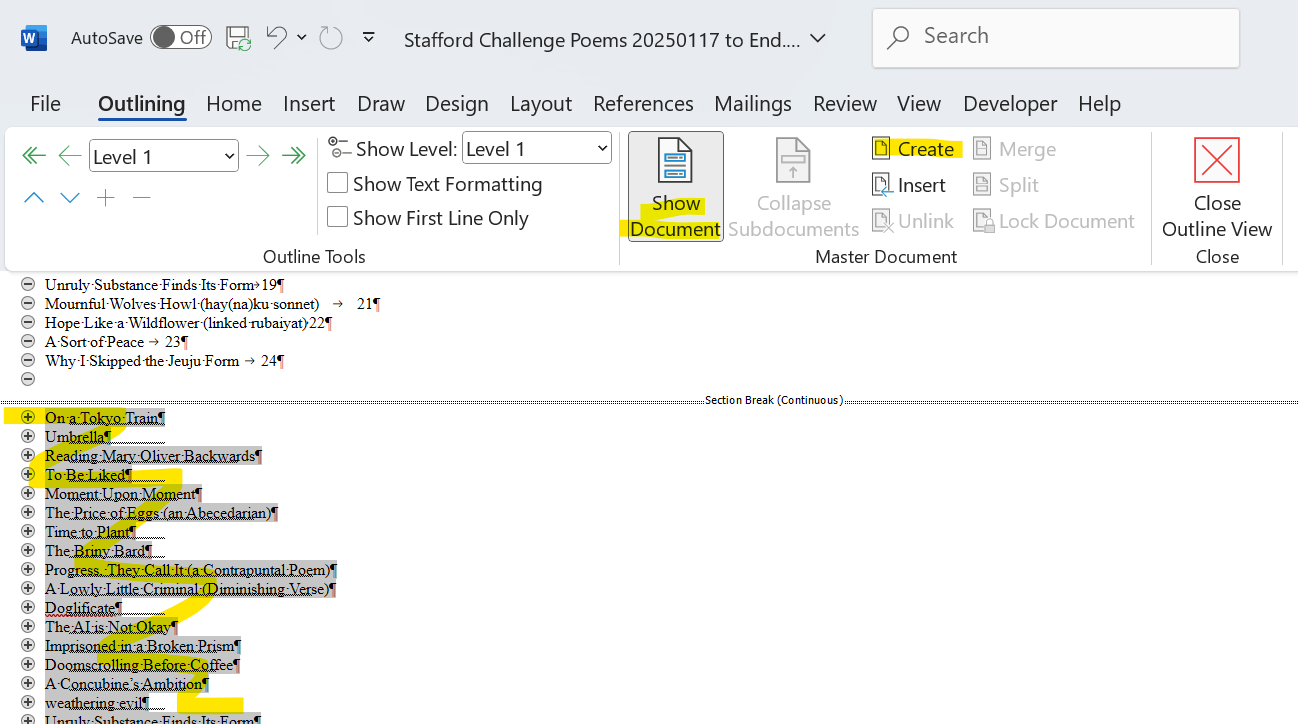
by Holly Jahangiri | Apr 1, 2025
April is, of course, National Poetry Month. And April 1st is the beginning of the A to Z Blogging Challenge, which I completed with a poem a day – in the spirit of NaPoWriMo / GloPoWriMo – in 2023. The Writers Digest Poem-a-Day (PAD) Challenge, which I did last November, begins anew today. And of course I’m in my second year of doing The Stafford Challenge, which is to write a poem a day for a whole year. Today is Day 75. This year? I’m doing them all. Plus entering 30 poetry contests, judging two, enjoying fun time with family, traveling to the last two of fifty states I haven’t yet visited, and attending Poetry at Roundtop. Yay!
Today’s poem was…
Originally titled, “Art Class.” After sharing it among a small group of poets who suggested a better title, I’m calling it “Origami Wings.”
I hate that writing, once it has “lost its virginity” by being published in any form, is devalued – never mind that there are, perhaps, 30 readers who will ever see it here on this blog. In 2023, Timothy Green proposed a new term of art that has gained some traction among publishers: “Uncurated.”
Imagine how literature would thrive if we could share our art with our friends in the medium of the era. How much more fun would online open mics be if everyone knew they were free to share the poem they were most proud of—the one they just wrote yesterday? Rattle’s weekly podcast includes a supportive and enriching open lines segment, but most poets are hesitant to share and “spoil” their newest work. The joy of sharing what we create is one of the main things that sustains us as artists. We shouldn’t have to wait years wading through rejection letters to feel it.
Read Green’s whole proposal at “Uncurated: The Case for a New Term of Art.” Unfortunately, this won’t work well for contests where anonymity is important to fairness. I was going to hold back, but a small voice in my head reminded me that words are meant to be read. Ideas are meant to be shared. Communication is an act requiring two or more.
Today’s Poem is…
Origami Wings
She made the most
exquisite corpse
folded over on itself
half a dozen times. The best
of times when flowers
graced her curves,
her ample breasts; the worst
of times, when they
cast cross-hatch shade
concentric circles,
levers, steampunk gears
between her hip-bones, thighs,
as if to mar her
nakedness and make of her
a twisted mess of cobbled parts
laid bare beneath
florescent glare for little
boys to snicker at,
while girls decided then
and there to bind
their chests, lean in
to art and ugliness,
express revulsion, silent
rage - while bleeding
ink through every knife-edged
paper crease, until
one artist's fingers
deft with mercy
turned her corpse to origami
folded arms to angels
wings and
let
her
fly

by Holly Jahangiri | Mar 22, 2025
It’s a Small World
About a week ago, a girl’s name popped into my head along with the impression that we’d been friends when we were little. Our moms must have been friends and I vaguely remembered something about eating lunch with her, possibly Spaghetti-Os. At least that was the visual snapshot – I can almost picture the table.
I had no idea how to spell her name. Fortunately, it’s not “Smith.” But who knows – women our age often changed our last names when we married, so the odds weren’t really in my favor. I did a Google search, anyway.
I found someone on Facebook who’d posted about a childhood memory of Kent State University that was uncannily similar to mine. I sent her a message and asked if she’d gone to the same Kindergarten I had gone to and did she remember the teacher.
She had! And she did. And after comparing what were, for both of us, vague and hazy snippets of memory, we were certain we were in the same class. We may even have taken ballet lessons elsewhere from the same instructor. Neither of us was any good at it and we both hated it.
But here’s the even funnier part: I told my daughter about this and mentioned where the woman worked. She replied with laughter and “you’re kidding?!” Turns out my friend is the Executive Director of a legal services non-profit that my daughter did a project for while she was working on her Masters degree. She is now more than halfway through law school, herself. But she and my friend had never met. Now they’re connected on LinkedIn.
I love odd, serendipitous moments like this.
Not in Kansas Anymore
But I was! After talking my husband into taking me to Santa Fe, Taos, and Los Alamos, New Mexico (one of two states, along with Kansas, that he had been to but I had not), I called up a friend in Lawrence, Kansas, and asked if she might have time to hang out with me for a day or two this month. Honestly – and no offense to what I’m sure is a beautiful state – visiting her was absolutely the only reason I could think of to go to Kansas. Now, Polli isn’t just any friend. I’ve known her for close to thirty years. Except that we’d never met face-to-face before. As for how we became friends in the first place, I think the post Gratitude and a List explains it best. I had a marvelous time exploring Lawrence, Kansas, seeing where my friend works, enjoying good food and good company. It was a short visit, but well worth the trip!

A(nother) Challenge, or Am I Just a Glutton for Punishment?
April is, of course, National Poetry Month. And April 1st is the beginning of the A to Z Blogging Challenge, which I completed with a poem a day – in the spirit of NaPoWriMo / GloPoWriMo – in 2023. The Writers Digest Poem-a-Day (PAD) Challenge. And of course I’m in my second year of doing The Stafford Challenge, which is to write a poem a day for a whole year. Today is Day 65. This year? I’m doing them all. Plus entering 30 poetry contests, judging two, enjoying fun time with family, traveling to the last two of fifty states I haven’t yet visited, and attending Poetry at Roundtop. Yay!

Upcoming
I have a poem published in Amazon.com: I Am From: Anthology of Essays, Poetry and Prose eBook : Brearley, Susan, Arvizu, Nanci, Barrett, Rebecca, Lemay, Melissa, Tomey-Zonneveld, Lisa, Nickerson, Shannon: Kindle Store
Necia Campbell – fellow mischief-maker – and I have a collaborative poem, “When the Last Cricket Sings,” that will be published by Collaborature on April 2, 2025. I have a URL, but WordPress will just gripe about it being a broken link until the poem is published, so I’ll wait and update this post later. If I remember.
Your Turn…
Leave me a comment: Tell me about your serendipitous moments, crazy projects and challenges, and good news!

by Holly Jahangiri | Feb 16, 2025
Each month, Poets Northwest meets in NW Houston to share poems and tips on writing poetry. Next month we’ll be focusing on revision, as well. This month, we were challenged to write an ekphrastic poem about a local artist or work of art displayed locally. It was there that I learned from friend and fellow member, Lynn G., about the Pearl Fincher Museum of Fine Arts – located about 15 minutes from me. I must live under a rock. I’ve been to the courthouse and I’ve been to the Barbara Bush Library, both of which are walking distance from the Pearl.
I called Lynn on Thursday to tell her I was going there to “do my homework.” I was already four blocks from my house when I asked her, “Wanna come?”
To my surprised delight, she said “Why not?” and pulled into the parking lot about 10 seconds after I got there.
“An artist date!” I think we both mentally pulled out our old copies of The Artist’s Way, by Julia Cameron.
Below, you’ll find my “homework,” an ekphrastic poem based on a work of art by Caroline Z. Marcos entitled, “Ocean Biome.” Several works of art inspired me, but this one tempted me to explore the images more deeply.
Nick Thacker, whom I met at last year’s Oklahoma Writers Federation Inc. (OWFI) Annual Conference, presented a session called “Write 80,000 Words in a Day.” I’ll admit that while I am not one of the rabid AI haters, I rolled my eyes at him and whispered, as he tried to convince me to stay, that the only way to produce that much output was with AI. I have too much professional pride to let AI write for me. And any AI images I use? I don’t ask friends to do free labor for me and I won’t pay for blog header images. I don’t trust “found on internet” freebies. And my own photos don’t always “go” with what I’m writing. But for anything involving a profit, like illustrations for a children’s book? You bet I’d pay a real artist.
That was probably a bad example, as I have yet to make a real profit from my children’s books, but you know what I mean – I hope.
“AI, but not what you think,” Nick said. “Stick around. You may be pleasantly surprised.” I did, and I was. He wasn’t suggesting the use of generative AI to write those 80,000 words after all. And (not) being from Missouri, but being somewhat skeptical, I tested his suggestions out right there during his session. He uses dictation – something I’m still too self-conscious to do – to draft the novel, then uses AI, acting as a proofreader/copy-editor to clean up grammar, spelling, and punctuation. It’s brilliant. And yes, you still have to read it and fix a few errors – it’s far from perfect and still quite human-centered.
One of my favorite ways to use AI as a tool is to analyze, list strengths and weaknesses in my writing, and offer suggestions. I have never seen it suggest its own words, and wouldn’t use them if it did. AI writes doggerel, at best. It can recite the rules of formal verse, but rarely manages to follow them. It can invent new forms – which is a fun new pastime of mine – but you have to be careful and check its work to ensure that it hasn’t just renamed an existing form.
As a critic, though, it is competent. I use it, occasionally, to ensure that my metaphors and similes aren’t too much of a leap – figuring that if AI gets the message I’m trying to convey, a human reader should have no trouble understanding it. I use it to make sure that symbolism is neither too obscure nor too obvious and cliché, to catch little speed-bumps and unintended repetition. It does a pretty decent job. And it offers constructive criticism without nastiness or sugar-coating, often treading where humans fear to tread in a misguided belief that heaping nothing but unconditional praise on a writer’s head is helpful. Sometimes, that praise is an understandable fear, like traversing a minefield. See Delicate Sensibilities. For real poets, it’s more like… | by Holly Jahangiri | Medium
As with human critique, it’s important to know what rings true and what makes no sense in the context of the writer’s vision. Here’s an example of where I used AI through three revisions of the following ekphrastic poem: ChatGPT Poem Analysis, Strengths & Weaknesses.

I think that ChatGPT is a little limited in its ability to “see” the artwork in question, though some image generators are able to analyze and describe an image. So the comments about the flowers and the “comet-fish” are not on point; I clarified the fish with its “tail on fire” but ignored ChatGPT’s suggestions about the flowers. Still, it was all just food for thought, and I agree with Cat Farts (my nickname for ChatGPT) that the last version is the strongest of the three, and I appreciate the feedback.

by Holly Jahangiri | Feb 6, 2025
If you’re not a poet, you may still find this useful – and you’re more than welcome to give it a try!
If you are writing for yourself, only, and not for publication, you can mostly ignore my advice about formatting everything in Times New Roman, 12pt, 1″ margins all around, blah blah blah… but trust me when I say that if you hope anyone but you will ever publish your work, you’d best get disciplined about reading submissions guidelines, first, and if they don’t explicitly specify formatting requirements, it’s Times New Roman, 12pt, 1″ margins all around. Don’t bother arguing about how it “looks prettier” with some other font – arguing this point will only get you labeled “argumentative, difficult to work with.”
Got that? If yes, you’ve probably just climbed over the backs of 70% of submissions and increased your odds of publication with that tip, alone. Here’s a freebie for you:
StaffordPoetryTemplate
This zip file contains a Microsoft Word Template (there’s a macro in there – it’s supposed to be in there – so if your antivirus or your Microsoft Word throw a fit, it’s your choice but I’d allow it if you like writing acrostic poetry). The zip file also contains a little htm document that you can run on your local drive to prep a poem for posting on Facebook. It’s not perfect, but it does a better job when copy/pasting of keeping your line breaks and horizontal spacing than just copy/pasting straight from Word. If it’s helpful, you can thank Dossy Shiobara for it. (You can open it in a text editor like Notepad to see what it does. It’s not particularly fancy and contains nothing “dangerous.”)
A member of The Stafford Challenge (2025 Cohort) asked, this morning, about organizing poems. I have tried numerous approaches, but the one that works best for me is to keep each years worth in a single Microsoft Word document. It is a very simple document: there is a Table of Contents (automatically generated from headings, of course – do I look like I have time to manually update page numbers??) and each page has a PoemTitle (a style I created: TNR + bold, 12pt.) followed by PoemBody (TNR, single-spaced lines). That is it. Oh – I got fancy with headers but there’s really no point since they don’t carry over when the document is split for publication.
You’re not going to submit 300+ poems to any journal all at once, surely. So rather than get in there and tediously make individual poem files one at a time, why not just collect them all and periodically extract them from the big file as individual files – in bulk?
How to Split a Microsoft Word Document into Individual Documents
You MUST use Heading Styles. In the following instructions, my poem titles are all set to a custom PoemTitle style, which is defined as a Level 1. (Heading 1 is, by default, defined as Level 1. You can define your own styles to be any Level you want them to be, and can then include or exclude them from your Table of Contents and Indices and format them any way you want to.)
IMPORTANT: The following instructions will create individual files which will be linked to a single Master Document. Use of Master Documents in Word is tricky and not recommended except for accomplishing a particular task (like creating individual files from a single large document). In fact, I’m going to strongly suggest that you first create a special folder on your local hard drive for this project, then put a copy of your large Word doc into it. Do not touch the original document for the rest of this exercise! Always, always, always have at least one backup of your work.
- Read the previous paragraph twice. When you have done that, you should be ready for the next steps.
- From the Word menu, working in your new copy of the original, select View > Outline.

- From the Show Level: drop down menu, select Level 1 (or whatever you’ve defined as your PoemTitle), then click Show Document.

- Select the headings (as shown below) that you want to save as individual documents. DO NOT SELECT THE TOC HEADINGS. In the Master Document section of the Ribbon, click Create.

- You will see something like this:

- You can double-click the document icon (circled in red) or CTRL+right-click on the file location to open the individual file (now known as a “subdocument”). You can use File Explorer to go to the location (highlighted above in yellow). If you see text instead of a file folder location, toggle the Expand/Collapse Subdocuments button shown on the Ribbon.
NOTE: Microsoft Office stores temporary cached files in a folder called: \AppData\Local\Microsoft\Windows\INetCache\Content.MSO

If you are working on a large file stored on OneDrive or other cloud storage, this is probably where the embedded, individual files are located. Moving them will destroy the integrity of the master document, which is why I recommend doing this only on your local hard drive. If working from a folder on your local hard drive, the individual files should be automatically created and saved for you in the same folder – this is much easier to deal with.
If you move these documents or rename the folder, all the links will be broken and your Master Document will be empty. You can always insert them, one by one, but this is tedious and not worth your time. My recommendation is to delete the Master Document (keep those individual files you created!) and repeat this process as needed to create individual files from a separate, large document. Remember: always work from a backup copy.

by Holly Jahangiri | Feb 1, 2025
There’s a list of “naughty words” floating around that apparently, government entities have been asked, in a very Orwellian directive, to expunge from their trainings, documents, and websites. Having looked at this list, I think those who’ve issued the directives might be better served by simply shutting up altogether.
Words, Words, Words
Here’s the list (so far) if you’re wondering why so many government websites are not working well today. I wouldn’t know where to begin, were I given the monumental task of removing words like “access” and “binary” from a user’s guide. I might gamely try, though, if I were feeling particularly subversive. The words “malicious compliance” spring merrily to mind. I just learned that term, yesterday. Also encountered, this week, were the delightful phrases, “Go f*** yourself sideways with a porcupine” and “You rank and wretched puke horse.”
ability
acceptance
access
affirmative
aggression
allyship
androgyne
asexual
belonging
bias
binary
bisexual
black
culture
deia
discrimination
diversity
eeo
empathy
empowerment
equitable
equity
ethnicity
fairness
gay
gender
gender dysphoria
handicap
homosexual
impartial
inclusion
inclusive
indigenous
intersectionality
intersex
justice
lgbtq
lgbtq+
lgbtqia
multiculturalism
native american
pansexual
power dynamics
privilege
queer
race
redistribution
representation
safe space
social justice
trans gender
transgender
transsexual
transvestite
under served communities
white
There are so many things I could say about each of these, but I will leave it to your imagination. I’ll admit to a small chuckle at the thought of having to delete all of the “white papers” that have no doubt been written at taxpayer expense. All reference to the “Department of Justice”? Gone. Pretty sure the Supreme Court is rolling nine pairs of eyes right about now. “Access” and “binary”? How will the techs maintain the computer systems, once all these words have been redacted or expunged?
Poetry from Putrescence
Instead, I thought these words should live and thrive—that they would make great prompts for my fellow poets! Here’s one of mine, so far:
Pondering Matthew 6:14
What’s empathy but an ability
to look beyond our biased binary
aggression: us or them. No nuanced choice—
discrimination hears no reasoned voice.
Death doesn’t ask consent, gives no respite
from wanton acts of bigotry and spite
Destruction answers; it’s affirmative—
diversity is dead. Alternative
ideas like equity not welcome here.
Conform at once—or die, and disappear
like fragile words that fall from satellites,
are lost to censored silence, endless nights.
There are no underserved communities
where allyship from privilege is a tease.
This conformation culture must please God
but I think their Christ might find it very odd.

As always, if you’re up for the challenge, please join in the fun – comment here with your poetry or a link to where we can all find it. And if you have the time, please read my latest piece on Medium, “There’s No Such Thing as Sex, Now.“













